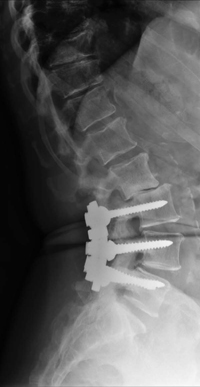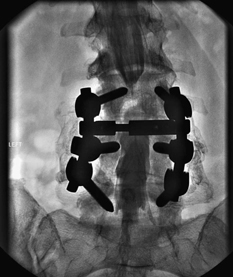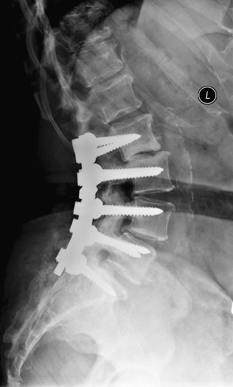38 A 68-year-old woman with two previous fusions was diagnosed with a new L3 radiculopathy and quadriceps weakness. A preoperative lumbar x-ray shows retrolisthesis of L2 on L3 (Fig. 38-1). Preoperative myelogram shows an L2-L3 extradural block, secondary to disc herniation (Fig. 38-2). A postoperative lumbar x-ray shows the correction of the listhesis with extension of the decompression and fusion (Fig. 38-3). FIGURE 38-1 Preoperative lumbar x-ray with L2–L3 listhesis. Adjacent segment disease, with postfusion spondylolis-thesis and disc herniation The patient’s fusion and decompression were extended to incorporate the failed rostral level and the sacrum. FIGURE 38-2 Myelogram demonstrating an epidural block. FIGURE 38-3 Postoperative x-ray with L2–S1 fusion an listhesis correction. Adjacent segment disease is a potential complication following fusion surgery. Debate has arisen as to whether this is the natural history of that segment in an already degenerative spine or whether this is iatrogenically accelerated. The answer is likely to be a combination of these processes. The differential of recurrent symptoms, or delayed symptoms after fusion surgery, is timeline related. In the days to weeks after surgery, infection will be a concern. In the first 3 to 6 months, pseudarthrosis with hardware failure is a possibility. Adjacent segment disease typically manifests itself in months to years after surgery. The workup necessitates magnetic resonance imaging (MRI) with and without gadolinium, and possibly a computed tomography (CT) myelogram if there is too much metallic artifact to interpret the MRI. Dynamic spine x-rays, as well as blood work (sedimentation rate, CBC, cultures) and electromyography with nerve conduction velocities are also useful. If a structural etiology is discovered, and further fusion surgery is planned, one must know the specifications of the already existing instrumentation. Knowing this preoperatively will enable the operating room staff to prepare the appropriate tools (screwdrivers, etc.) prior to the moment of utilization. The surgeon may plan to remove the existing instrumentation or link with it. Having the appropriate tools ready before beginning such an endeavor maximizes efficiency. When revising pedicle screws, one must be cognizant of thread type changes, as well as have other options of screw removal if the available drivers fail. Also important to revision fusion surgery is the ability to differentiate scar tissue from normal tissue. This is done by extending the incision to incorporate normal tissue planes rostrocaudally and using precaution when dissecting through scar tissue. This patient had adjacent segment disease rostrally with instability. Her long-arm fusion had a “floating” rostral segment, and the new fusion was lengthened to accommodate it as well as the sacrum. While there is debate as to when S1 should be incorporated into a lumbar fusion, in the case of extant adjacent segment disease and multiple fused levels, the sacrum should be recruited into the construct for increased stability. Interbody fusion can help realign sagittal balance and reestablish disc height. However, if there is too much scarring, and the patient is elderly, the risks of this procedure may outweigh the benefits. The recent introduction of motion sparing technology is meant to minimize adjacent segment disease. Its use is not applicable here due to the degree of three-column degenerative change, location, and other comorbidities. Nonetheless, the future development of this and other technology may change the incidence and the way adjacent segment disease is treated. Javedan SP, Dickman CA. Cause of adjacent-segment disease after spinal fusion. Lancet 1999;354:530–531
Adjacent Segment Disease
Presentation
Radiologic Findings

Diagnosis
Treatment


Discussion
SUGGESTED READING
< div class='tao-gold-member'>
Adjacent Segment Disease
Only gold members can continue reading. Log In or Register to continue

Full access? Get Clinical Tree








